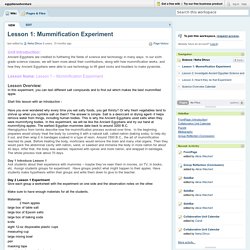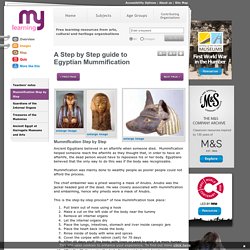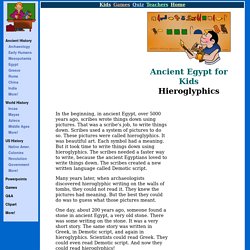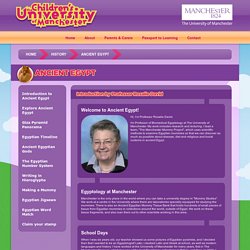

Lesson Plan: Making a Mummy. Ultimate Social Studies Series - Over 2,900 Printables - For All Grade Levels View Now...

Need Tons of New Worksheets? - 50,000+ Worksheets - Teachers Love It! View Now... Lesson Plan Title : Making a Mummy Age Range: Grade 3 through Grade 5 (Elementary) Overview and Purpose: Is that you, "Mummy"? Objective: The student will be able to demonstrate the basic principle of removing moisture from an object to mummify it. Egyptianadventure / Lesson 1: Mummification Experiment. Unit Introduction: Ancient Egyptians are credited to furthering the fields of science and technology in many ways.

In our sixth grade science classes, we will learn more about their contributions, along with how mummification works, and how they Ancient Egyptians were able to use technology to lift giant rocks and boulders to make pyramids. Lesson Name: Lesson 1 – Mummification Experiment Lesson Overview: In this experiment, you can test different salt compounds and to find out which makes the best mummified apple. Start this lesson with an introduction - Have you ever wondered why every time you eat salty foods, you get thirsty? Hieroglyphics from tombs describe how the mummification process evolved over time.
Day 1 Introduce Lesson 1 Ask students about their experience with mummies – maybe they’ve seen them in movies, on TV, in books, etc. Day 2 Lesson 1 Experiment Give each group a worksheet with the experiment on one side and the observation notes on the other. Materials 2 fresh apples knife. Dervish. Mummies. Mummy Experiment - learn how mummies were made in Ancient Egypt. Have you ever wondered why every time you eat salty foods, you get thirsty?

Or why fresh vegetables tend to shrivel up when you sprinkle salt on them? The answer is simple. Salt is a desiccant - it helps remove water from things, including human bodies. Which is why the Ancient Egyptians used salts when they were mummifying bodies. In this experiment, you can test different salt compounds and to find out which makes the best mummified apple. Materials 2 fresh apples large box of table salt large box of Epsom salts large box of baking soda knife eight 12-oz disposable plastic cups measuring cup large mixing bowl pen masking tape sensitive balance or food scale (optional) paper and pencil Slice the two apples into quarters so that you have eight slices similar in size. Questions Which salt would seem to work best at making an apple mummy?
Salts and special drying solutions played important roles in preserving mummies, but they also served another purpose. Find more Science Experiments. A Step by Step guide to Egyptian Mummification. Ancient Egyptians believed in an afterlife when someone died.

Mummification helped someone reach the afterlife as they thought that, in order to have an afterlife, the dead person would have to repossess his or her body. Egyptians believed that the only way to do this was if the body was recognisable. Mummification was mainly done to wealthy people as poorer people could not afford the process. The chief embalmer was a priest wearing a mask of Anubis. Ancient Egypt for Kids and Teachers - Ancient Egypt for Kids. Games & Stories - Ancient Egypt for Kids. Short Stories - Ancient Egypt for Kids. Hieroglyphics & the Rosetta Stone - Ancient Egypt for Kids. In the beginning, in ancient Egypt, over 5000 years ago, scribes wrote things down using pictures.

That was a scribe's job, to write things down. Scribes used a system of pictures to do so. These pictures were called hieroglyphics. It was beautiful art. Each symbol had a meaning. Many years later, when archaeologists discovered hieroglyphic writing on the walls of tombs, they could not read it. One day, about 200 years ago, someone found a stone in ancient Egypt, a very old stone. This stone was named the Rosetta Stone. Ancient Egypt - Menu page. Ancient Egypt. Welcome to Ancient Egypt!

Hi, I’m Professor Rosalie David. I'm Professor of Biomedical Egyptology at The University of Manchester. My work includes research and lecturing. I lead a team, "The Manchester Mummy Project", which uses scientific methods to examine Egyptian mummies so that we can discover as much as possible about disease, diet and religious and burial customs in ancient Egypt. Egyptology at Manchester Manchester is the only place in the world where you can take a university degree in "Mummy Studies".
School Days When I was six years old, our teacher showed us some pictures of Egyptian pyramids, and I decided then that I wanted to be an Egyptologist! Mummy Research Our research adds new information to Egyptology. "What illnesses did the Egyptians suffer from? " "Can we trace some diseases through from ancient to modern times? " "What medical treatments did the Egyptians use, and would they work today? " "How did the Egyptians mummify their dead? " ODYSSEY/Egypt.